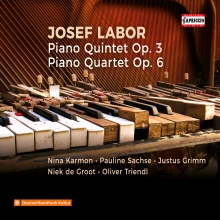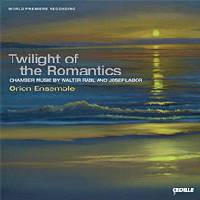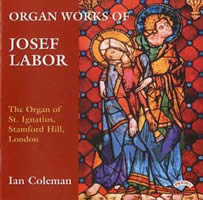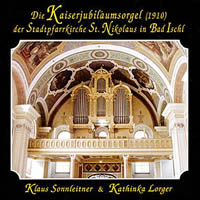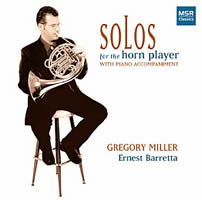Josef Labor Discography Update
|
Grant Chu Covell [December 2019.] [Originally published November 2004 as part of Wittgenstein’s Music, Music’s Wittgenstein, and Josef Labor, and first updated May 2009.]
Josef LABOR: Piano Quintet, Op. 3 (1886)1; Piano Quartet, Op. 6 (1893)2. Nina Karmon1,2 (vln), Pauline Sachse1,2 (vla), Justus Grimm1,2 (vlc), Niek de Groot1 (cbs), Oliver Triendl1,2 (pno). Capriccio C5390 (1 CD) (http://www.capriccio.at/). Labor recordings take a big forward step with this chamber music pair. (Labor is decidedly obscure, but his organ music is better represented.) These Romantic works in textbook forms may not approach the intricacy of Schumann or Brahms, but there are memorable moments and plenty to admire. Both are played with flair; I would put this on my “Best of 2019” if I made lists. Labor’s Quintet exchanges second violin for contrabass following the example of Schubert’s Trout Quintet. With its warm minor-key melodies, easy alternation of duple and triple, and confident interplay between piano and strings, the Quintet aligns more with Brahms than does the Quartet. Perhaps it is the presence of contrabass, but the E-minor quintet nearly cries out for orchestra in its dispersal of ideas and instruments. An impish Scherzo (with two trios) leads to a contemplative Andante, and a tidy Allegro ma non troppo including a fugato wraps everything up. Just several years later, the Quartet’s brighter harmonies suggest Tchaikovsky rather than something Austrian. The C-major quartet’s opening Allegro embeds a wonderful sinuous piano gesture that concludes phrases, and the theme of the third movement (Quasi Allegretto) appears with subtle evolution in the concluding Allegro ma non troppo. (Perhaps the grace notes are out of place.) Labor’s Op. 6 is dedicated to Leopoldine Wittgenstein, the mother of Paul and Ludwig.
“Twilight of the Romantics.” Walter RABL: Quartet in E flat major for clarinet, violin, cello and piano, Op. 1 (1896). Josef LABOR: Quintet in D major for clarinet, violin, viola, cello and piano, Op. 11 (1900). Orion Ensemble: Kathyrne Pirtle (clar), Florentina Ramniceanu (vln), Jennifer Marlas (vla), Judy Stone (vlc), Diana Schmück (pno). Cedille Records CDR 90000 088 (http://www.cedillerecords.org/). Released in 2006, this Cedille release contains a piece which Wittgenstein presumably played himself, Labor’s Clarinet Quintet. Like Brahms, Labor makes much of contrasting duple and triple, however with a flexible manner and lighter hand. The four-movement work proceeds according to Classical plan, though the brief slow movement marked Quasi Fantasia: Adagio, which offers heightened drama recalling stormy Beethoven, introduces the following theme and variations. A welcome project would group Labor’s quintet with similar works by Brahms and Robert Fuchs. Walter Rabl’s quartet isn’t more adventurous than his more familiar peers, though there are figurations in the Adagio molto suggesting Fauré’s quartets and quintets with piano.
“Organ Works of Josef Labor.” Josef LABOR: Sonata, Op. 15 (1912); selections from Seventeen Preludes (1908); Improvisations, Op. 13; Fantasia, Op. 9 (1908); Three Interludes (1914); Fantasia for Organ Duet, Op. 12 (1912?). Ian Coleman, Ann Carey (The Organ of St. Ignatius, Stamford Hill, London). Priory PRCD 688 (http://www.priory.org.uk/). This Priory collection demonstrates Labor effectively combining melody and harmony in short forms. These airy works, sounding like Brahms’ late choral pieces, afford the organist ample opportunities for color, one of this recording’s more pleasurable aspects. The preludes and interludes are light and brief, emotional subtlety taking precedence over pompous virtuosity. The Sonata and Fantasia, Op. 9, are multi-movement essays, the latter an eight-part theme and variations on the Austrian national anthem. Given the Haydn-attributed theme’s overuse during the past century, it’s hard not to wince at the initial statement and during the fugue’s most grandiose sections. With its efficient themes and counterpoint, the Sonata’s three movements nicely cohere, the closing Chaconne reflecting Bach studies.
“Die Kaiserjubiläumsorgel (1910) der Stadtpfarrkirche St. Nikolaus in Bad Ischl.” Adolph Friedrich HESSE: Fantasie für Orgel zu vier Händen, Op. 87. Johannes BRAHMS: four preludes from Elf Choralvorspielen, Op. 122 (1896). Anton BRUCKNER: Festmusik (ca. 1890, arr. Erwin Horn). Josef LABOR: Orgel-Fantasie für zwei Spieler, Op. 12 (1912?); Sonate h-Moll, Op. 15 (1912); Fantasie über die Volkshymne von Haydn, Op. 9 (1908). Klaus Sonnleitner, Kathinka Lorger (The Kaiserjubiläumsorgel, Bad Ischl, Austria). Edition Lade EL CD 022 (http://www.edition-lade.com/). This organ recital offers Labor’s Opp. 9, 12 and 15 alongside works by Brahms, Hesse and Bruckner. I’m not surprised that Hesse (1809-1863) is an unfamiliar name. The virtuosic Fantasie is a blustery, thankfully brief, multi-part affair. Brahms wrote his chorale preludes as a memorial to Clara Schumann. The four selected here are delicate teasers featuring welcome illustrations of this instrument’s registrations. The Bruckner, a grand romp, was pieced together by Erwin Horn from sketches and other Bruckner works. A subset of Labor’s entire organ output, these three pieces demonstrate the composer’s pedagogical bent and breadth. Given that its material became the Austrian national anthem, Haydn’s Variations sound a little corny. The B-minor Sonata, a bit more serious in scope than the two-player Fantasie, demands the most attention. Whether intended or not, this recital leaves one with the impression that late-Romantic German organ music was predominantly secular.
“Solos for the Horn Player with Piano Accompaniment.” Asst. comps. incl. Josef LABOR: Theme and Variations, Op. 10 (1899?). Gregory Miller (hn), Ernest Barretta (pno). MSR Classics MS 1147 (http://www.msrcd.com/). Mason Jones’ pedagogical collection for horn and piano includes arrangements as well as works specifically scored for that combination (Glazunov’s Reveries, Op. 24, Dukas’ Villanelle, etc.). Several are concert or chamber works in which the accompanying parts have been arranged for piano (Rondo from Mozart’s E-flat Horn Quintet, K. 407, Scherzo from Beethoven’s Septett, Op. 20, Saint-Saëns’ Romance, Op. 36, Ravel’s Pavane, etc.). In its horn and piano arrangement, the Andante from Mendelssohn’s “Reformation” Symphony comes across as a tad funereal. Apparently this is the first recording of Jones’ 1962 publication in its entirety. The most vigorous pieces, Dukas’ Villanelle and Brahms’ Scherzo, from the Serenade, Op. 11, are particularly exciting. The longest entry here, Labor’s Op. 10 Theme and Variations, asks for cello or horn. After the soloist’s extended introduction, the pianist keeps busy. Having heard this sober and slightly archaic work on horn, I can’t imagine it providing much satisfaction in a cello version. Despite Miller’s lyric playing and Barretta’s even support, my attention wandered. The brief notes inform us that Labor was a friend to Paul Wiggenstein [sic!]. [More Grant Chu Covell]
[Previous Article:
EA Bucket 28.]
[Next Article:
Used Bin Troll Tweets NN.]
|
